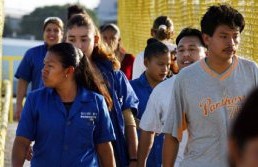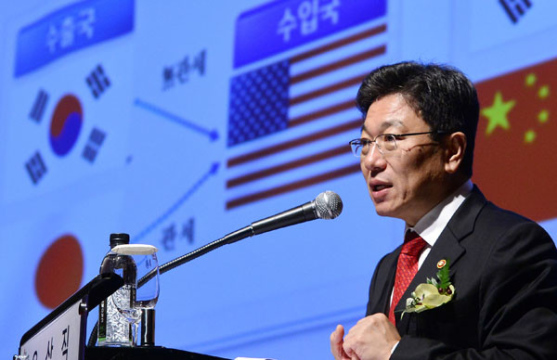
Mexican vs Chinese Factories
With the rising cost of wages in China, manufacturers are increasingly considering Mexico an attractive location to ‘re-shore’ production.
This post is also available in: Spanish
Following the publication of a report on the creation of inter-sectoral agreements to help improve secondary education and employability of young people in Mexico, Federico Sucre (Program Assistant for Education at the Inter-American Dialogue) interviewed Mónica Tapia-Álvarez (Director of Synergos Mexico), one of the three authors of the report.
FS: Synergos recently published a report called “Building Inter-Sectoral Agreements to Improve Secondary Education and Employability of Young People in Mexico.” In short, what was your analysis and what did you discover?
MTA: This report compiles data from recent research by several think-tanks, multilateral agencies, governments, and researchers, and includes a qualitative assessment of numerous initiatives undertaken by civil society organizations, foundations, businesses, and governments in Mexico. There is a consensus on the urgency to act now, on a generation of 21 million young Mexicans (of which 8 million have no educational or employment opportunities). They represent the demographic “bonus” of our country, but without those opportunities, they risk becoming a “liability”. It is a generation that represents the possibility of social mobility – living better than their parents – or replicating the same cycle of poverty in which they have lived.
The purpose of this report is to define the problem in a better way, to “map” the social factors behind the lack of opportunities and the dropout rates of high school students, the obstacles that they face when getting their first job, and the consequences these phenomena have on society, such as lower labor competitiveness, greater inequality, and potential violence, among others.
This report, supported by the Lodestar Foundation, also includes the first dialogue among people who know the problems well and are working on solutions with different approaches. This dialogue comes from foundations that offer “standardized” solutions such as scholarships and technological equipment for youth centers, to those more personalized initiatives that accompany them in their most important decisions and offer them choices: what to study, where to work, how to prepare for a job interview, and many other life skills that need to be developed.
FS: The study found that since 2000, only 200,000 jobs were created annually, on average, for the 800,000 Mexicans who enter the workforce each year. What strategies do you propose to deal with this lack of employment?
MTA: The simplistic interpretation is that few formal jobs are being created for the number of young people currently entering the labor market, but it is paradoxical that several employer surveys say that companies only manage to cover 50% of their openings. This suggests a more complex issue that goes beyond the creation of more jobs. It should be interpreted with a systemic approach: the school system is not preparing the necessary human capital and wages for these first jobs are very low. The options for many young people are informal employment, migration, or living without working or studying (subsisting on the income of other family members). If we use that interpretation of the problem, various strategies are needed: reforms in access to and quality of secondary education, which can also improve their relevance; stronger links between school and employment through work experience, employment agencies, and “soft skills” training (responsibility, teamwork, persistence, long-term vision). Companies and business associations also have a role in creating job opportunities and improving their human resource policies, working with other middlemen between school and work. Our best bet is collaboration among various actors, each one having a better understanding of the relations and causes of the problem and acting more effectively in their respective roles.
FS: Who are the “ninis” (neither work, nor study for its acronym in Spanish)? And, why do you think Mexico has the third highest percentage of “ninis” among the OECD countries?
MTA: From our perspective, the “ninis” should be actually renamed “sinsin” (without, without in Spanish) because we have not been able to provide them with educational or job opportunities. They are young people (about 8 million) who are not studying because they have not had the access or the ability to continue their secondary education, and are not working because, given their poor educational credentials, they have few job opportunities available. Enrollment in upper secondary education (grades 10-12) is still low and represents the greatest challenge for the current education system, even when – or because of the fact that – we have the highest enrollment in primary and lower secondary education (grades 1-9). Not only are there few opportunities to study, but there is also a huge dropout rate: it is estimated that 650,000 young people leave school every year. Various reasons help explain these dropout rates: learning disabilities and problems with the teachers, bullying, teen pregnancy, the ease of obtaining an income in the short-term by working, the limited transportation resources and educational materials, parents’ low expectations, among many others.
FS: A central point of the report talks about coordinating the actions of public and private actors. Do you find that there are good experiences to build up partnerships?
MTA: Partnerships are processes that require maturation. The challenge used to be primary and lower secondary education, and today we are in a different context, facing a growing youth population. Existing initiatives are quite new; most are no more than five to seven years old. Some organizations have 30 years working with young people, but fewer years designing processes for job placement or dropout prevention. There are some recent partnerships, generally between 2 partners (funders and organizations, universities and organizations, government and universities); some more complex ones like NEO Monterey – where there are 11 participating companies, various government agencies, national and international organizations, and part of the funding from multilateral agencies – are just launching their operations, and we will be learning from their experience.
It is a suitable time to do this compiling exercise, exchanging experiences and engaging in a dialogue to find shared visions, but it is clear to us that the inter-sector partnerships also require maturation and medium-term horizons. We are just in the beginning phase and, therefore, expectations should be modest.
FS: What has been the reaction to the study? Do you think that Mexican society is becoming more aware of the low quality of secondary education and the serious problems of employability of young adults?
MTA: The report reflects the acknowledgement and action on these emerging and heartfelt social problems. It has attracted a lot of interest; it helps to think about the deep and multi-factorial causes and at the same time it portrays the actions that have started to be designed and implemented. The report has also been well received by those who want to understand the problem in a nutshell, and by those who want to get involved in this collaborative process and dialogue. We are curious about the lack of response by the education and labor authorities, who have had little involvement in this process. Since they have exclusively concentrated in managing the complex and fragmented government programs, they have failed to realize all the complementary efforts carried out by civil society, foundations, and companies. There is awareness about the violence and the stories of young people recruited by gangs, but during the sustained dialogue the idea of changing this narrative was also considered. Young people who are currently in high school come from families who have put a lot of effort and from the development of the education system, which should not stay truncated. We have to create opportunities for these young people, who come from a merit-based generation, who make their parents proud, who represent and deserve expectations for a better future. We all need to work in a more collaboratively way to build these opportunities for them.
FS: You have proposed the creation of a forum for further discussion. What do you expect to achieve with this effort in the coming year?
MTA: We have created a collaborative space, inviting the various initiatives that are working on these issues (we have been meeting and inviting them). On the one hand, there is a virtual space to exchange information and to disseminate the research, experiences, learning (assessments, methodologies), and debates on public policy. On the other hand, we have proposed two in-person meetings per year, with active working committees and follow-up agreements. The process consists of building a common vision of the problem, prioritizing, and acting on solutions, as well as measuring the tangible and intangible objectives to be achieved. As Synergos, our role is to facilitate these collaborative processes.
With the rising cost of wages in China, manufacturers are increasingly considering Mexico an attractive location to ‘re-shore’ production.
South Korea’s entry into the TPP will promote stronger cooperation between South Korea and Latin America.
Mexican civil society organizations and individuals are pressing for education reform, including reducing the Teachers’ Union.
